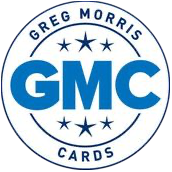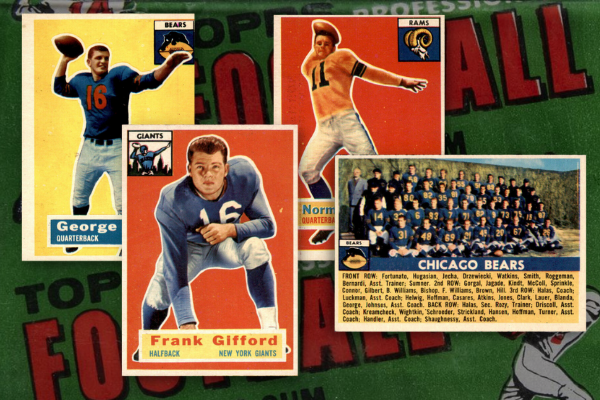The fall of 1956 was a hinge moment for American football.
Thanks to a television agreement between the NFL and CBS that took effect that year, and thanks to the emergence of powerhouse teams like the New York Giants and Chicago Bears, American audiences across the the nation were quickly falling in love with football.
Attendance was soaring at places like Yankee Stadium and Wrigley Field, but not just for baseball. Football was bringing fans to the stadium for the first time, and with American audiences clamoring for more gridiron action, the new television deal with CBS provided even more exposure.
Along with football’s meteoric rise, and simultaneous to the already stalwart presence of baseball in American culture, was the growth of what would become another staple for sports fans: Topps.
Having just acquired all of Bowman’s licenses for baseball and football, Topps was eager to put out a sports card line to appeal to the new football fan, just as it had done with its popular baseball cards between 1952-1955.
After Topps’ “All-American” set in 1955, which ostensibly toppled the once-dominant Bowman Gum company, Topps now had the license to print and sell all of football’s greatest stars. No need to print retired stars or college football greats anymore. Now they could have the “real thing” when it came to professional football cards.
What followed was a 120-card set with some of football’s greatest players of all time.
1956 Topps Football: The Set
Topps released the set in one series, a diversion from their usual method of selling cards in multiple series throughout the season. This was presumably because Topps was unsure if the cards would sell, or it could have been a byproduct of trying to squeeze football card production in the middle of their massive baseball card business.
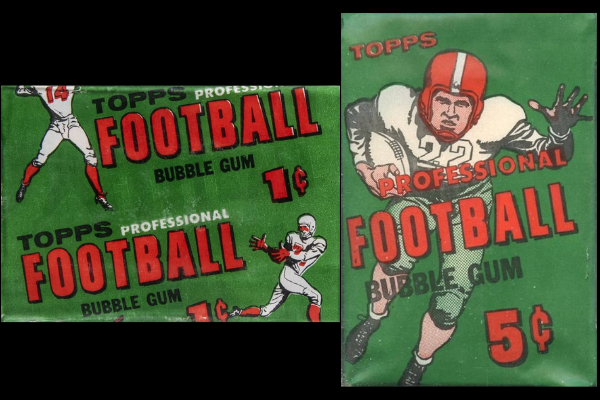
There were 120 cards in the set. All 12 NFL teams were represented, including the popular New York Giants, Chicago Bears, Cleveland Browns, and Green Bay Packers. Washington Redskins and Chicago Cardinals cards were short printed.
The cards were slightly larger than modern football cards, measuring at 2 5/8″ by 3 5/8″. The small difference between the vintage and modern Topps football cards is one you might not notice unless you see them next to each other, though the difference between the Topps and Bowman football cards is more dramatic.
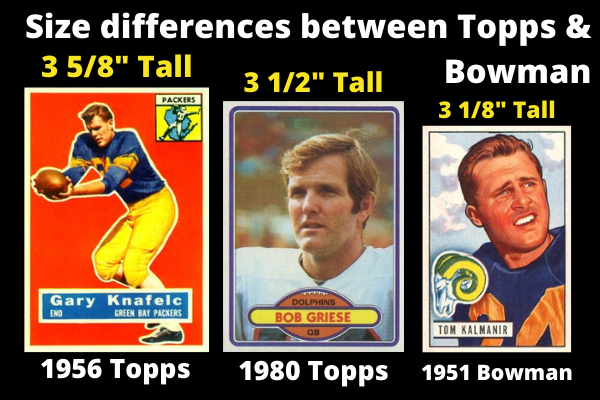
The 1956 Topps set also included team cards, such as this one for the Green Bay Packers, for the first time ever.
1956 Topps Football: The Players
There was no shortage of football legends in the 1956 Topps set.
Lou Groza (#9), Frank Gifford (#53), Y.A. Tittle (#86), Norm Van Brocklin (#6), and George Blanda (#11) round out the top Hall of Famers in the set, along with Joe Schmidt (#44), Elroy Hirsch (#78), and Stan Jones (#71).
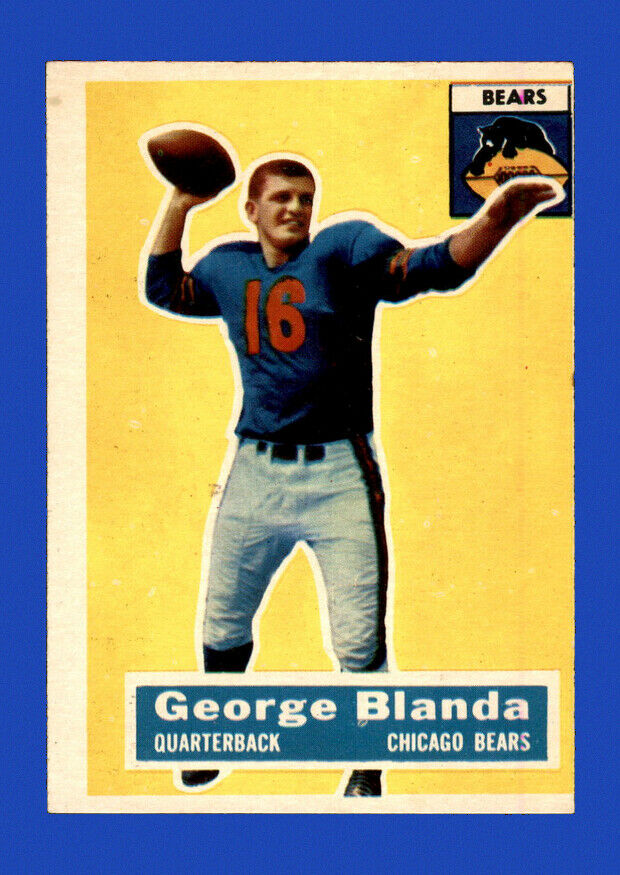


Rookie cards include Lenny Moore (#60) and Roosevelt Brown (#41).
In all, there are 25 Hall of Famers in the set. Amazing, given there are only 120 cards in the set.
1956 Topps Football: The Art
The prominent art on the 1956 Topps cards are the action poses placed in front of single color backgrounds. The team logos are similar in style to the 1955 Topps All-American design: square frame with the logo and the team name included.
The action shots were particularly striking. Players in mid-catch or mid-tackle were common. Running and passing stances looked like they were pulled directly from the CBS broadcast. Everything about the 1956 Topps cards was very life-like and customers opening the cards would certainly have been satisfied with the quality of the product Topps provided.
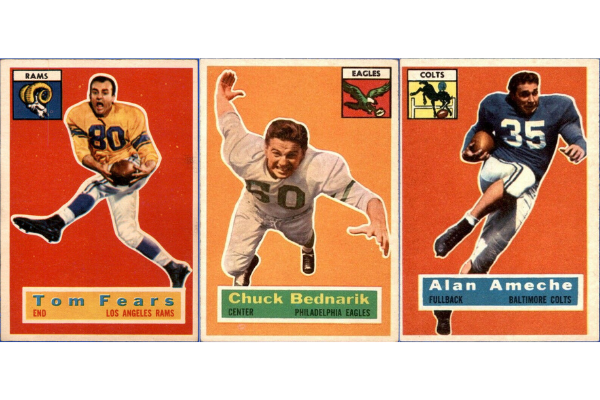
Front nameplates include the player’s name, position, and team name, but the real detail, as always with Topps, was on the back of the cards.
The back of the cards featured a plethora of information. Height, weight, birthday, and previous statistics were the staples, plus there was always text about the player and a cartoon or trivia question. All of it was arranged in a familiar design that Topps customers had come to expect by 1956.

This amount of detail and player information on each card was one of the things that set Topps apart from other card manufacturers. The iconic 1952 Topps Baseball design began the trend, and the success of that product led to more of the same from Topps in the coming decades.
Valuing the 1956 Topps Football set
Given the star power and the era in which they were produced, collecting a full set of 1956 Topps Football is not inexpensive.
But compared to many baseball card sets from the same era, the cost is reasonable.
For example, a full set of 1956 football in PSA 6 (EX) holders will cost right around $5,000. If you want the cards in near mint condition (PSA 8), you’ll spend north of $35,000, and a full set of PSA 10 copies will run you well over $100,000.
The toughest cards to add to your set will be the Hall of Famers, but don’t forget about the short printed Redskins and Cardinals cards. For example, the average PSA 6 for Quarterback Lamar McHan of the Cardinals (card #118) sells for $124. Compare that to Hall of Famer Y.A. Tittle’s card #56 which sells for only around $54.
Shortprints include McHan (#118), Dale Atkeson (#109), John Olszewski (#106), Billy Wells (#97), Chuck Ulrich (#94), Joe Scudero (#85), Jack Simmons (#82), Volney Peters (#73), Don Stonesifer (#70), Ollie Matson (#58), Eddie LeBaron (#49), Len Teeuws (#46), Chuck Drazenovich (#37), Dave Mann (#34), Leon Heath (#25), Vic Janowicz (#13), Tom Bienemann (#10), and Jack Carson (#1).
If you are looking to get started on your 1956 Topps Football collection, Greg Morris Cards can help! Click this link to see all of the auctions we have featuring the 1956 Topps Football set.
Sources: “The Complete Picture Collection of Topps Football Cards 1956-1986” by Jack Clary; vintagecardprices.com; pro-football-reference.com
